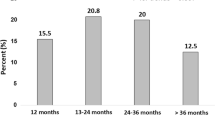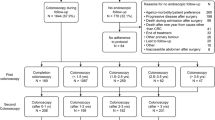Abstract
Purpose. We analyzed the possible risk factors for metachronous colon tumors after endoscopic resection of initial tumors.
Methods. Three hundred and twenty-one patients entered the surveillance study after colonoscopic resection of initial tumors between 1985 and 1999. Histology of initial tumors was adenoma in 214 patients and carcinoma in 107 patients. Solitary tumor was observed in 196 patients and multiple tumors in 125 at initial endoscopy. The median surveillance period was 39 (range, 12–112) months, and the median frequency of surveillance colonoscopy was three (range, 2–10) times.
Results. Metachronous neoplasms were identified in 114 of 321 surveillance cases (36%). In the 114 cases, the number of patients with metachronous adenoma was 103 (90%) and that of carcinoma was 11 (10%). Clinical characteristics at entry – including age, gender, multiplicity of polyp, histology of polyp, and site of polyp – were not different between patients with metachronous tumors and those without metachronous tumors. Kaplan-Meier analysis revealed that patients with a histology of carcinoma and those with multiple polyps at entry developed metachronous tumors significantly earlier than did patients with initial adenomas and initial solitary polyp, respectively (P<0.001, P<0.001). However, other characteristics at entry did not produce significant differences in the rate of the development of metachronous tumors using Kaplan-Meier analysis. Proportional hazards model analysis revealed that histology of the initial tumor as carcinoma (relative risk, 1.690, 95% confidence interval, 1.118–2.555) and multiplicity (1.472, 1011–2.143) were significant risk factors for metachronous colon tumors. The 75%, 50%, and 25% metachronous tumor-free periods after initial polypectomy were 14, 21, and 39 months, respectively.
Conclusions. These results may help optimizing surveillance strategies for metachronous colon tumors and raising the economic benefit of colonoscopy.
Similar content being viewed by others
Author information
Authors and Affiliations
Additional information
Electronic Publication
Rights and permissions
About this article
Cite this article
Fukutomi, Y., Moriwaki, H., Nagase, S. et al. Metachronous colon tumors: risk factors and rationale for the surveillance colonoscopy after initial polypectomy. J Cancer Res Clin Oncol 128, 569–574 (2002). https://doi.org/10.1007/s00432-002-0375-9
Received:
Accepted:
Issue Date:
DOI: https://doi.org/10.1007/s00432-002-0375-9




